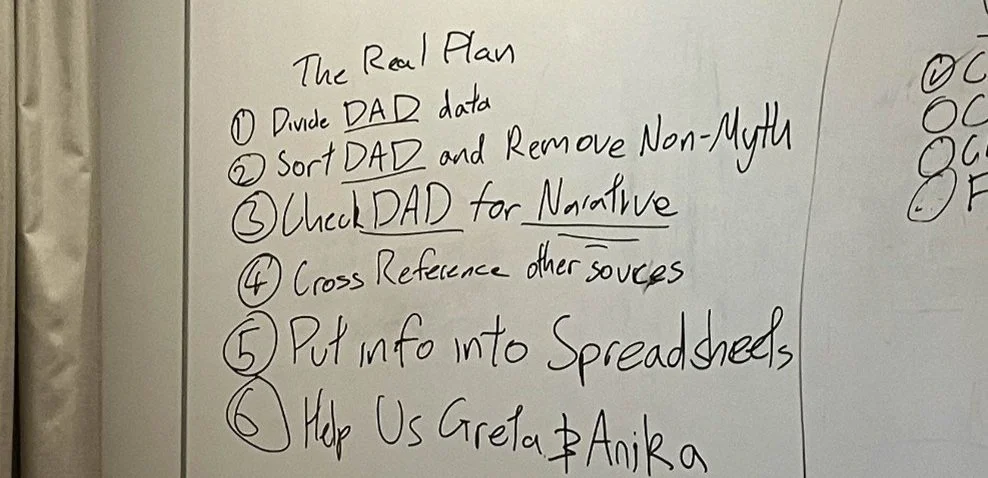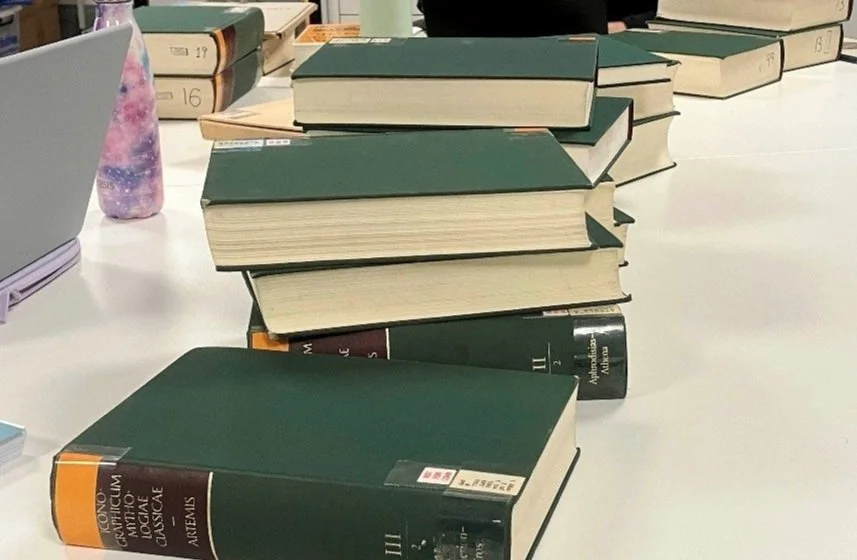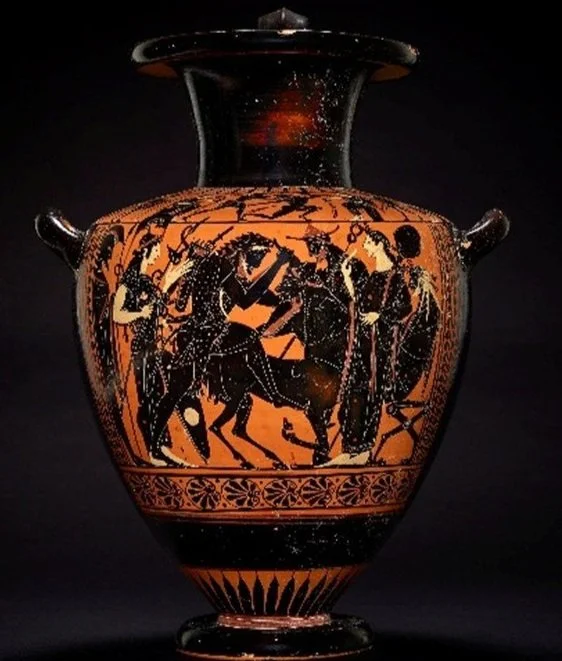Pots and Pan: Exploring the Mythical Greek World
written by Maxim Angelos
In the first semester I had the chance to participate in the honestly startlingly extensive MANTO project. Coming into the project I had little idea what to actually expect from the experience. Would we be working with physical sources and artefacts? As it turned out: no. Despite that initial disappointment, I found myself enjoying the experience far more than I would have expected. Our focus was on documenting and cataloguing ancient Greek shield bands recovered from Olympia, with the aim of expanding MANTO’s database.
Day one priorities.
Photo: M. Angelos
What is a Shield-Band?
Whilst previous interns in previous years had focused on documenting and recording the stunningly preserved wall paintings in Pompeii, the focus of our phalanx of students was on an entirely different kettle of Sirens. The German Archaeological Institute (DAI) began excavations at the ‘Altis’, or “grove”, but more commonly recorded as ‘Sanctuary’, at Olympia in 1875, and immediately turned up remnants of temples dedicated to Zeus and Hera. But the excavation also turned up small fragments of bronze, depicting scenes from Greek mythology. These were eventually determined to be ancient hoplite shield-bands, decorative strips of Bronze (metopes) that were attached to the leather strap that secured the shield to the arm (porpax). Their presence demonstrates the wealth of the owner, as they would have added to the cost of an already expensive item. But as Greta notes in her own blog post, these shield bands possess a personal complexity, being visible only to the wearer of the shield. This provides an intimate element to them; what did the scenes shown mean to this person?
Our work was focused on sorting and cataloguing over 200 shield bands provided by the Gdansk Decorated Armour Database (DAD), picking out mythical scenes depicted. From there, we utilised LIMC, a catalogue of depictions of mythical scenes, to identify and label each scene depicted.
Day five: the physical LIMC. Thank the gods for the digital LIMC.
Photo: M. Angelos
These shield-bands were recovered from Olympia, where they had been used as infill in the stadium embankment. It is theorised that they were offered as sacrifices to the gods, and that they were cleared away when they accumulated beyond what the temple staff wished to preserve. This created an interesting dichotomy between the individual value, and the collective worthlessness.
Corpus Vasorum Antiquorum: Pots and Pan
As our time on campus came to a close, I chose to complete my work with the Corpus Vasorum Antiquorum, the international records of ancient pottery. I had been greatly interested in the 1931 vintage records from the British Museum and jumped at the chance to take another look at them and quickly focused on the black-figure hydrias.
1931 vintage CVA (Great Britain 8, British Museum 6)
Photo: M. Angelos
Hydrias are vessels primarily used to contain water that were popular from the late Geometric (7th Century BCE) to the Hellenistic periods (3rd Century BCE). The hydrias in the collection of the British Museum are stunningly well preserved, and their striking scenes immediately draw the eye. The one depicted below is one of my favourites, depicting Theseus slaying the Minotaur on the upper shoulder of the pot, and the uncommonly depicted myth of Herakles fighting the river god Acheloos on the main body of the hydria.
Attic black figure hydria attributed to the Leagros group, depicting Theseus slaying the Minotaur on the upper shoulder, and Heracles fighting the river god Acheloos on the body. British Museum B313.
Photo: Trustees of the British Museum, available under Creative Commons.
Not only is this hydria immaculately well preserved and detailed, with almost every element of the scene recorded, but they demonstrate the culture that these were created in. These hydrias are just as much about telling a story as they are practical vessels for holding water or wine. The incredible intricacy of the art allows for artistic tells to be noted, and individual artists can be diagnosed from their art styles. Even if that intricate art is just Herakles beating a lot of people up.
Final Thoughts:
I greatly enjoyed the chance I had to work with my peers, Greta and her assistant Anika on this project. Despite preferring to work alone, I was pleasantly surprised by how much I enjoyed interacting and working with my fellow interns. I would highly recommend students interested in Ancient History look at MANTO for their placements.
With thanks to the team of MANTO and DAD who provided the opportunity to work on these shield bands, and the team at Macquarie University History Museum for hosting us.
And thanks to my fellow Macquarie University interns - Chris Hitchens, Archie Mercer, Victor Russo, Ruby Woodbury - and supervisors Anika Campbell and Greta Hawes for working with me on this project.
This is the third in a series of blog posts from students at Macquarie University who are participating in this semester’s PACE internship.




